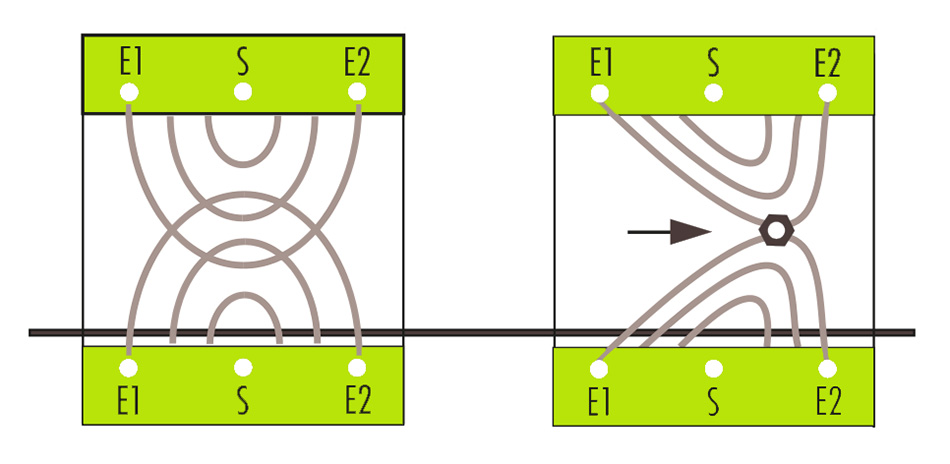

Metal detectors for food primarily are used for the purpose of consumer protection. Despite maximum care metallic contaminations of food products during the production process cannot be fully excluded. Metal particles that enter the product during the production process or already are contained in the raw material may cause serious injuries of consumers. The consequences for the producing company are numerous and serious and include compensation claims and expensive recalls. Even bigger and longer-lasting damage is caused by the negative brand image and the loss of consumer trust caused by impure food products.
Metal detectors for food provide effective protection against ferrous
and non-ferrous metals (aluminium, stainless steel, etc.). They can be
installed in every step of the production process and can be used for
many different applications, e.g. for the inspection of bread and bakery
products, meat and sausage product, fruit, vegetables, dairy products,
spices, sugar, etc.
In addition to consumer protection, metal detectors also are used to
protect machinery. Even smallest metal particles can lead to machinery
failure. Expensive repairs and production downtimes are the
consequences, often followed by revenue decreases.
When used for machinery protection, the metal detector is installed
directly before the machine to be protected. If, as in most cases in the
food industry, consumer protection is the goal, several inspection
points are useful. An inspection of raw material has the advantage that
metal particles are separated before they are broken up into smaller
pieces which might be harder to detect. Inspections at critical control
points (HACCPs) during the production process are recommended to notice
machinery failures (such as broken blades) in time.
Consequently, food products in their final stage after packaging are
inspected once again with a metal detector (or an X-ray system) to fully
exclude contamination.
For optimal product protection an inspection of raw materials, of several critical control points, and a final inspection of the finished product are recommended.

Such metal detectors are equipped with a transmitter coil and two receiver coils. The transmitter coil generates a constant electromagnetic field. When a metal particle passes the detector it interferes with the electromagnetic field, causing a signal to be detected by the receiver coils. The electronic unit in the metal detector analyses this signal, evaluates it and signals a metal contamination. As a rule metal detectors in the food industry are equipped with automatic reject units that directly separate the contaminated product from the production line.
The selection of your country allows us to offer the optimal content for you.
We have detected the following country based on your IP address:
If this is not correct, please choose your country below.
Aland Islands Albania Andorra Armenia Austria Aserbaidschan Belarus Belgium Bosnia-Herzegovina Bulgaria Croatia Cyprus Czech Republic Denmark Estonia Faroe Islands Finland France Georgia Germany Gibraltar Greece Guernsey Vatican City Hungary Iceland Ireland Isle of Man Italy Jersey Kazakhstan Kosovo Kyrgyzstan Lattvia Liechtenstein Lithuania Luxembourg Macedonia Malta Moldavia Monaco Montenegro Netherlands Norway Poland Portugal Romania Russia San Marino Serbia Slovakia Slovenia Spain Sweden Switzerland Tajikistan Turkey Turkmenistan Ukraina United Kingdom Uzbekistan
Anguilla Antigua & Barbuda Aruba Bahamas Barbados Belize Bermuda Canada Cayman Islands Costa Rica Cuba Curaçao Dominica Dominican Republic El Salvador Greenland Grenada Guadeloupe Guatemala Haiti Honduras Jamaica Martinique Mexico Montserrat Nicaragua Panamá Puerto Rico Saint Barthélemy Saint Kitts and Nevis Saint Lucia Saint Martin (French part) Saint Pierre and Miquelon Saint Vincent and the Grenadines Sint Maarten (Dutch part) Trinidad and Tobago Turks and Caicos Islands USA United States Virgin Islands British Virgin Islands Netherlands Antilles
Afghanistan Bahrain Bangladesh Bhutan British Indian Ocean Territory Cambodia China Taiwan India Indonesia Iran Iraq Israel Japan Jordan North Korea South Korea Kuwait Laos Lebanon Macao Malaysia Maldives Mongolia Myanmar Nepal Oman Pakistan Palestinian Territory, Occupied Philippines Qatar Saudi Arabia Singapore Sri Lanka Syria Taiwan Thailand Timor-Leste United Arab Emirates Vietnam Yemen
Algeria Angola Benin Botswana Burkina Faso Burundi Cameroon Cape Verde Central African Republic Chad Comoros Republic of the Congo Democratic Republic of the Congo Ivory Coast Djibouti Egypt Equatorial Guinea Eritrea Ethiopia Gabon Gambia Ghana Guinea Guinea-Bissau Kenya Lesotho Liberia Libya Madagascar Malawi Mali Morocco Mauritania Mauritius Mayotte Mozambique Namibia Niger Nigeria Reunion Rwanda Saint Helena, Ascension and Tristan da Cunha Sao Tome and Principe Senegal Seychelles Sierra Leone Somalia South Africa South Sudan Sudan Swaziland Tanzania Togo Tunesia Uganda Western Sahara Zambia Zimbabwe
American Samoa Australia Brunei Christmas Island Cocos (Keeling) Islands Cook Islands Fidschi French Polynesia Guam Heard Island and McDonald Islands Kiribati Marshall Islands Micronesia Nauru New Caledonia New Zealand Niue Norfolk Island Palau Papua New Guinea Pitcairn Samoa Solomon Islands Tokelau Tonga Tuvalu Vanuatu Wallis and Futuna Northern Mariana Islands